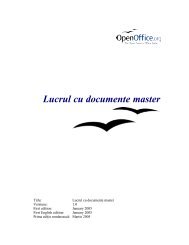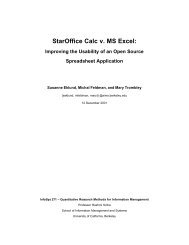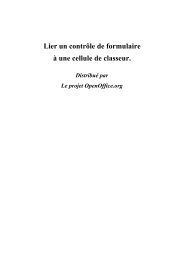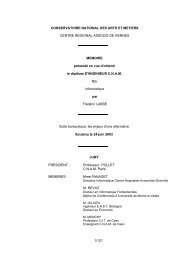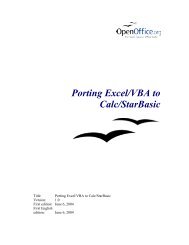- Page 1 and 2: OpenOffice.org's Documentation of t
- Page 3 and 4: 4.12 Conditional Formatting Table (
- Page 5 and 6: 5.104 TOPMARGIN 213 5.105 UNCALCED
- Page 7 and 8: 1.2 Abstract 1.2 Abstract This docu
- Page 9 and 10: 1.2 Abstract • Record Content Lis
- Page 11 and 12: 2.1 Document Types 2.1.3 Workbook D
- Page 13 and 14: 2.2 The Binary Interchange File For
- Page 15 and 16: 2.3 File Structure 2.3.3 Worksheet/
- Page 17 and 18: 2.5 Common Record Substructures 2.5
- Page 19 and 20: 2.5 Common Record Substructures •
- Page 21 and 22: 2.5 Common Record Substructures 2.5
- Page 23 and 24: 2.5 Common Record Substructures Ins
- Page 25 and 26: 2.5 Common Record Substructures 2.5
- Page 27: 2.5 Common Record Substructures 2.5
- Page 31 and 32: 3.1 Common Formula Structure 3.1.6
- Page 33 and 34: 3.2 Token Classes 3.2.3 Expected Pa
- Page 35 and 36: 3.2 Token Classes • Current posit
- Page 37 and 38: 3.3 Cell Addresses in Tokens 3.3.2
- Page 39 and 40: 3.3 Cell Addresses in Tokens 3.3.4
- Page 41 and 42: 3.4 Token Overview 3.4.4 Constant O
- Page 43 and 44: 3.4 Token Overview • Classified T
- Page 45 and 46: 3.6 Binary Operator Tokens 3.6 Bina
- Page 47 and 48: 3.6 Binary Operator Tokens 3.6.9 tE
- Page 49 and 50: 3.7 Function Operator Tokens 3.7 Fu
- Page 51 and 52: 3.8 Constant Operand Tokens 3.8 Con
- Page 53 and 54: 3.8 Constant Operand Tokens 3.8.7 t
- Page 55 and 56: 3.9 Operand Tokens 3.9.3 tArea (25
- Page 57 and 58: 3.9 Operand Tokens 3.9.7 tMemFunc (
- Page 59 and 60: 3.9 Operand Tokens 3.9.12 tMemAreaN
- Page 61 and 62: 3.9 Operand Tokens 3.9.15 tRef3d (3
- Page 63 and 64: 3.9 Operand Tokens 3.9.17 tRefErr3d
- Page 65 and 66: 3.10 Control Tokens 3.10 Control To
- Page 67 and 68: 3.10 Control Tokens • Volatile Fo
- Page 69 and 70: 3.10 Control Tokens • CHOOSE Func
- Page 71 and 72: 3.10 Control Tokens • Sum with On
- Page 73 and 74: 3.10 Control Tokens In the followin
- Page 75 and 76: 3.11 Built-In Sheet Functions Func
- Page 77 and 78: 3.11 Built-In Sheet Functions 3.11.
- Page 79 and 80:
4 Worksheet/Workbook Stream 4 Works
- Page 81 and 82:
4.2 Record Order in Streams and Sub
- Page 83 and 84:
4.2 Record Order in Streams and Sub
- Page 85 and 86:
4.2 Record Order in Streams and Sub
- Page 87 and 88:
4.3 Calculation Settings Block 4.3
- Page 89 and 90:
4.6 Cell Formatting 4.6 Cell Format
- Page 91 and 92:
4.7 Cell Table and Row Blocks 4.7.3
- Page 93 and 94:
4.7 Cell Table and Row Blocks • F
- Page 95 and 96:
4.7 Cell Table and Row Blocks • F
- Page 97 and 98:
4.9 Multiple Operation Tables 4.9 M
- Page 99 and 100:
4.10 Internal and External Referenc
- Page 101 and 102:
4.10 Internal and External Referenc
- Page 103 and 104:
4.10 Internal and External Referenc
- Page 105 and 106:
4.10 Internal and External Referenc
- Page 107 and 108:
4.10 Internal and External Referenc
- Page 109 and 110:
4.10 Internal and External Referenc
- Page 111 and 112:
4.11 Shared String Table (BIFF8) 4.
- Page 113 and 114:
4.15 AutoFilter, Advanced Filter 4.
- Page 115 and 116:
4.18 Worksheet/Workbook Protection
- Page 117 and 118:
4.19 File Protection 4.19 File Prot
- Page 119 and 120:
4.19 File Protection • BIFF2-BIFF
- Page 121 and 122:
5.1 Overview, Ordered by Record Ide
- Page 123 and 124:
5.1 Overview, Ordered by Record Ide
- Page 125 and 126:
5.2 Overview, Ordered by Record Nam
- Page 127 and 128:
5.3 Overview, Ordered by BIFF Versi
- Page 129 and 130:
5.3 Overview, Ordered by BIFF Versi
- Page 131 and 132:
5.3 Overview, Ordered by BIFF Versi
- Page 133 and 134:
5.5 BACKUP 5.5 BACKUP BIFF2 BIFF3 B
- Page 135 and 136:
5.8 BOF - Beginning of File 5.8 BOF
- Page 137 and 138:
5.9 BOOKBOOL 5.9 BOOKBOOL BIFF2 BIF
- Page 139 and 140:
5.13 CALCCOUNT 5.13 CALCCOUNT BIFF2
- Page 141 and 142:
5.16 CFRULE - Conditional Formattin
- Page 143 and 144:
5.16 CFRULE - Conditional Formattin
- Page 145 and 146:
5.17 CODEPAGE 5.17 CODEPAGE BIFF2 B
- Page 147 and 148:
5.19 COLUMNDEFAULT 5.19 COLUMNDEFAU
- Page 149 and 150:
5.22 COUNTRY 5.22 COUNTRY BIFF2 BIF
- Page 151 and 152:
5.24 DATATABLE - Multiple Operation
- Page 153 and 154:
5.26 DATAVALIDATION 5.26 DATAVALIDA
- Page 155 and 156:
5.29 DBCELL 5.29 DBCELL BIFF2 BIFF3
- Page 157 and 158:
5.33 DEFINEDNAME 5.33 DEFINEDNAME B
- Page 159 and 160:
5.33 DEFINEDNAME • Option Flags B
- Page 161 and 162:
5.36 DSF - Double Stream File 5.36
- Page 163 and 164:
5.38 EXTERNALBOOK - External Workbo
- Page 165 and 166:
5.39 EXTERNALNAME 5.39.3 Record Con
- Page 167 and 168:
5.41 EXTERNSHEET 5.41.2 Record Cont
- Page 169 and 170:
5.43 FILEPASS Record FILEPASS, BIFF
- Page 171 and 172:
5.45 FONT 5.45 FONT BIFF2 BIFF3 BIF
- Page 173 and 174:
5.46 FONT2 5.46 FONT2 BIFF2 BIFF3 B
- Page 175 and 176:
5.49 FORMAT Some of the built-in nu
- Page 177 and 178:
5.50 FORMULA • Result of the Form
- Page 179 and 180:
5.52 GRIDSET 5.52 GRIDSET BIFF2 BIF
- Page 181 and 182:
5.56 HIDEOBJ 5.56 HIDEOBJ BIFF2 BIF
- Page 183 and 184:
5.58 HYPERLINK • Option Flags The
- Page 185 and 186:
5.59 INDEX 5.59 INDEX BIFF2 BIFF3 B
- Page 187 and 188:
5.63 LABEL 5.63 LABEL BIFF2 BIFF3 B
- Page 189 and 190:
5.68 MULBLANK - Multiple BLANK 5.68
- Page 191 and 192:
5.71 NUMBER 5.71 NUMBER BIFF2 BIFF3
- Page 193 and 194:
5.73 PAGESETUP Record PAGESETUP, BI
- Page 195 and 196:
5.74 PALETTE 5.74 PALETTE BIFF2 BIF
- Page 197 and 198:
5.75 PANE 5.75 PANE BIFF2 BIFF3 BIF
- Page 199 and 200:
5.80 PRINTGRIDLINES 5.80 PRINTGRIDL
- Page 201 and 202:
5.85 REFMODE 5.85 REFMODE BIFF2 BIF
- Page 203 and 204:
5.88 ROW Record ROW, BIFF3-BIFF8: O
- Page 205 and 206:
5.91 SCENPROTECT 5.91 SCENPROTECT B
- Page 207 and 208:
5.96 SHEETLAYOUT 5.96 SHEETLAYOUT B
- Page 209 and 210:
5.99 SORT 5.99 SORT BIFF2 BIFF3 BIF
- Page 211 and 212:
5.102 STRING 5.102 STRING BIFF2 BIF
- Page 213 and 214:
5.104 TOPMARGIN 5.104 TOPMARGIN BIF
- Page 215 and 216:
5.109 WINDOW1 5.109 WINDOW1 BIFF2 B
- Page 217 and 218:
5.110 WINDOW2 5.110.2 Option Flags
- Page 219 and 220:
5.115 XF - Extended Format 5.115 XF
- Page 221 and 222:
5.115 XF - Extended Format • XF_A
- Page 223 and 224:
5.115 XF - Extended Format Record X
- Page 225 and 226:
6 Drawing Objects 6 Drawing Objects
- Page 227 and 228:
7.1 Document Integration 7.1.2 Char
- Page 229 and 230:
7.2 General Chart Structure 7.2 Gen
- Page 231 and 232:
7.3 Common Record Blocks 7.3 Common
- Page 233 and 234:
7.3 Common Record Blocks 7.3.6 CHDE
- Page 235 and 236:
7.5 Record Overview, Ordered by Nam
- Page 237 and 238:
7.7 CHAXISLINE 7.7 CHAXISLINE BIFF2
- Page 239 and 240:
7.9 CHEND - End of Block 7.9 CHEND
- Page 241 and 242:
7.11 CHLINEFORMAT 7.11 CHLINEFORMAT
- Page 243 and 244:
7.13 CHSTRING 7.13 CHSTRING BIFF2 B
- Page 245 and 246:
9 Change Tracking 9 Change Tracking
- Page 247 and 248:
10.1 Workspace Stream Structure of
- Page 249 and 250:
10.3 INDEX 10.3 INDEX BIFF3W BIFF4W





